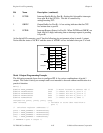Chapter 4 Register-Level Programming
© National Instruments Corporation 4-19 PC-DIO-96 User Manual
Mode 2 Programming Example
The following example shows how to configure PPI A for mode 2 input and output and how to
use the handshaking signals to control data flow. This code is strictly an example and is not
intended to be used without modification in a practical situation.
Main() {
#define BASE_ADDRESS 0x180 /* Board located at address 180 */
#define APORTAoffset 0x00 /* Offset for PPI A, port A */
#define APORTBoffset 0x01 /* Offset for PPI A, port B */
#define APORTCoffset 0x02 /* Offset for PPI A, port C */
#define ACNFGoffset 0x03 /* Offset for PPI A, CNFG */
unsigned int porta, portb, portc, cnfg;
char valread; /* Variable to store data read from a
port */
/* Calculate register addresses */
porta = BASE_ADDRESS + APORTAoffset;
portb = BASE_ADDRESS + APORTBoffset;
portc = BASE_ADDRESS + APORTCoffset;
cnfg = BASE_ADDRESS + ACNFGoffset;
/* EXAMPLE 1*/
outp(cnfg,0xC0); /* Port A is in mode 2. */
while (!(inp(portc) & 0x80)); /* Wait until OBFA* is set, indicating
that the data last written to port A
has been read. */
outp(porta,0x67); /* Write the data to port A. */
while (!(inp(portc) & 0x20)); /* Wait until IBFA is set, indicating that
data is available in port A to be read.
*/
valread = inp(porta); /* Read data from port A. */
}
Interrupt Programming Examples for the 82C55A
The following examples show the process required to enable interrupts for several different
operating modes. The interrupt handling routines and interrupt installation routines for the
82C55A are not included; however, sample routines for the 8253 are included later in the
chapter. These routines can be modified to function for the 82C55A. Consult the IBM Personal
Computer XT Technical Reference manual for additional information. Also, if you generate
interrupts with the PC3 or PC0 lines of the 82C55A devices, you must maintain the active high
level until the interrupt service routine is entered. Otherwise, the host computer considers the
interrupt a spurious interrupt and routes the request to the channel responsible for handling
spurious interrupts. To prevent this problem, try using some other I/O bit to send feedback to the
device generating the interrupt. In this way, the interrupting device can be signaled that the
interrupt service routine has been entered. For further information on using PC3 and PC0 for
interrupts, see the section entitled Interrupt Handling, later in this chapter.


















